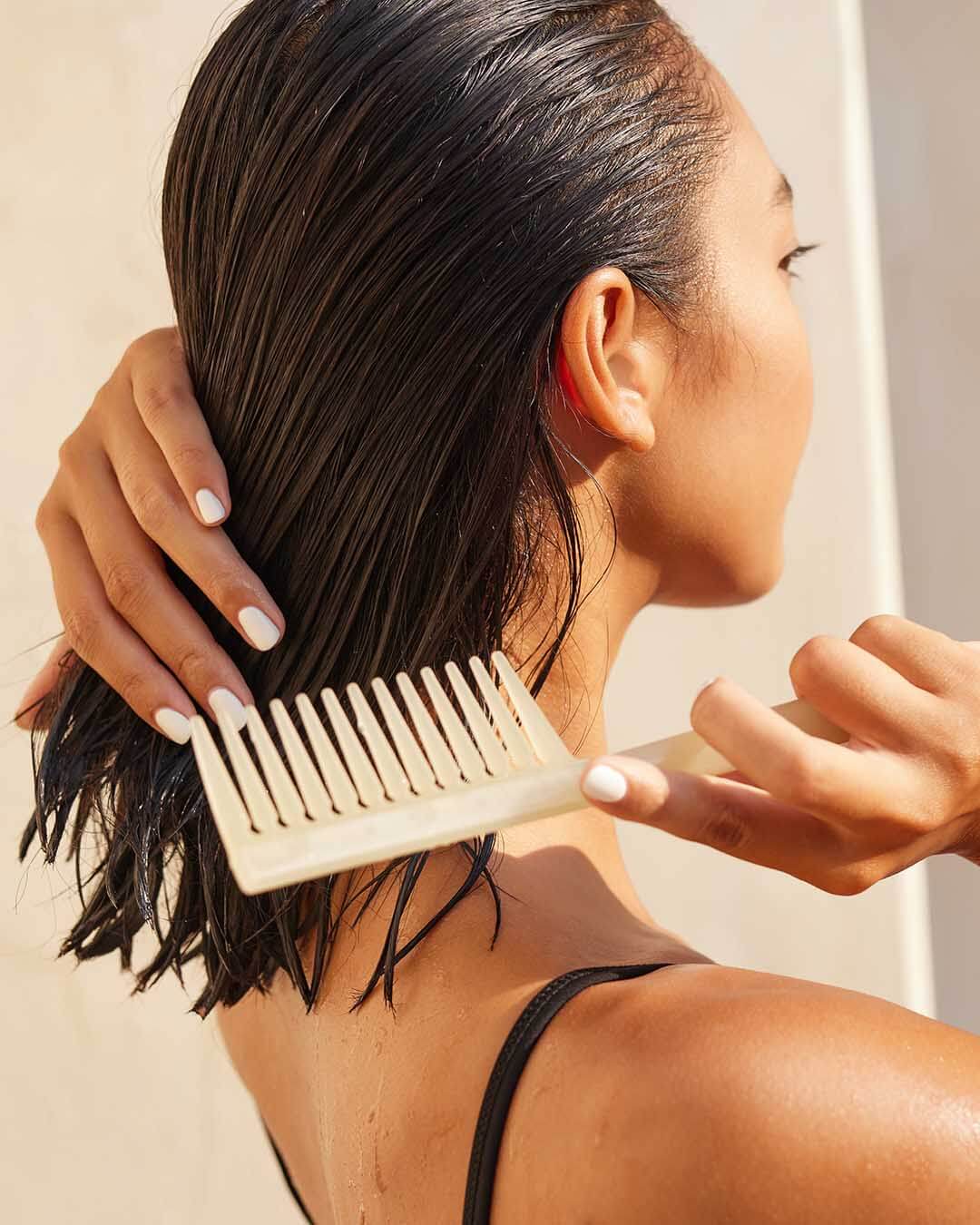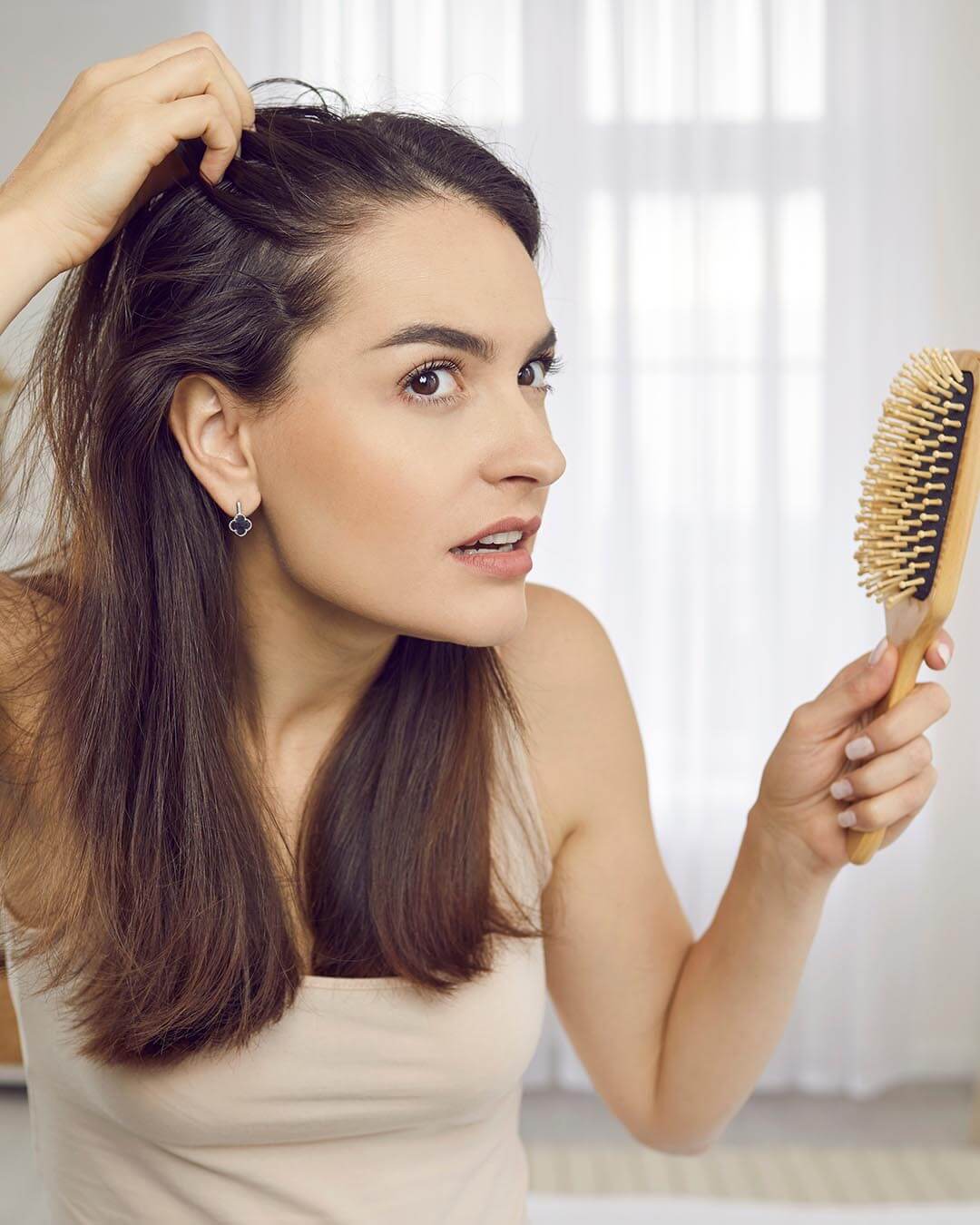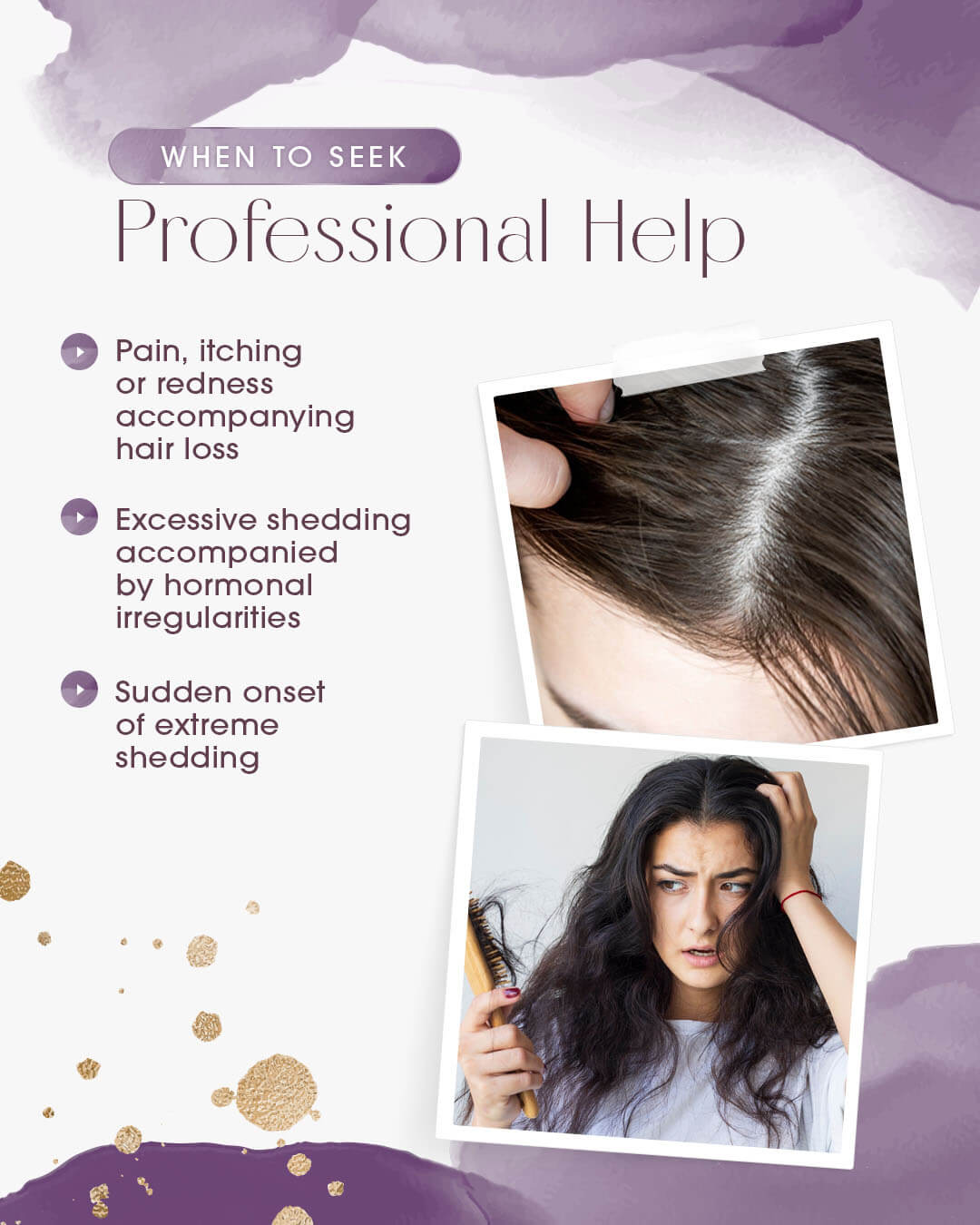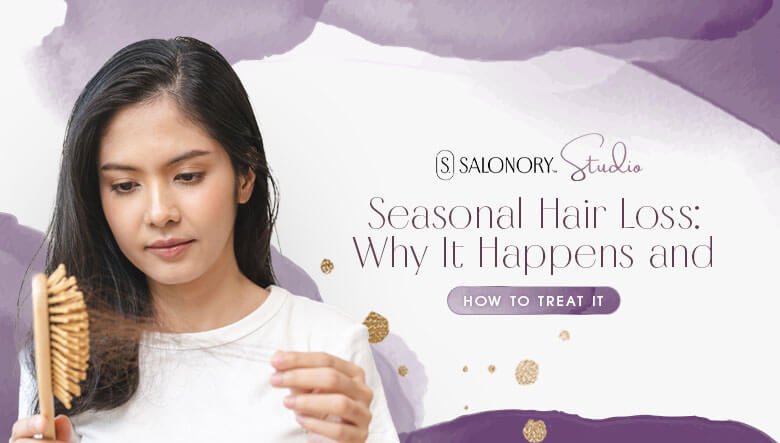Do you notice more hair in your shower drain during certain times of the year? You might be experiencing seasonal hair loss, a common phenomenon that affects many people. This natural cycle of increased shedding often causes concern, but understanding the science behind it can help you manage and treat it effectively. Read on to learn more about seasonal hair loss and why scalp health is important to maintaining luscious locks.
Understanding the Hair Growth Cycle
The human hair growth cycle includes three main phases: anagen (growth), catagen (transition) and telogen (resting). During the telogen phase, hair follicles rest before shedding to make way for new growth. A typical scalp has approximately 85-90 percent of hairs in the anagen phase, while 10-15 percent remain in telogen.
Research suggests our bodies adjust these percentages seasonally. Studies across the globe have documented patterns where more hairs enter the telogen phase during late summer and early fall, resulting in increased shedding during autumn. This biological response likely evolved from our ancestors’ adaptation to environmental changes.

The Science Behind Seasonal Shedding
Seasonal hair loss follows predictable patterns tied to annual environmental changes. Scientists have observed two main shedding peaks throughout the year. For most people, fall shedding begins in late September or November. This occurs because more hair follicles enter the telogen phase during summer, creating a delayed shedding effect as seasons change. Spring shedding takes place between March and May, though this pattern is usually less pronounced than autumn hair loss.
Several biological factors contribute to these cycles. Temperature changes affect blood circulation to the scalp, potentially altering hair growth cycles. In addition, hormonal fluctuations correlate with seasonal changes in light exposure, influencing hair growth patterns. Summer UV exposure can damage hair follicles, and stress from seasonal transitions, including changes in activities, schedules and vitamin D levels, can impact hair growth.
How to Identify Seasonal Hair Loss
Distinguishing seasonal shedding from other types of hair loss is the first step in determining an appropriate treatment. True seasonal hair loss has several distinct characteristics. The timing coincides with seasonal transitions, and the volume of shedding increases but remains uniform across the scalp without creating patches. Women experiencing seasonal hair loss often report finding more hair in brushes, shower drains or on pillows. While alarming, this increased shedding rarely causes visible thinning since only a fraction of the total hair enters the shedding phase.
Increased seasonal shedding generally lasts four to eight weeks, and regrowth follows naturally without intervention.
Baby Hairs or Breakage: Spotting the Difference
Depending on whether they are baby hairs or breakage, the short hairs around your hairline can indicate new growth or damage. Baby hairs are new growth with tapered, fine ends and varying lengths. They emerge as part of the regular growth cycle and appear more noticeable during recovery from seasonal shedding. Breakage has blunt ends, often appears brittle or split and is most common in areas exposed to friction or styling stress. It occurs as a result of mechanical or chemical stress rather than natural shedding.
Examine the ends of short hairs carefully. Tapered tips indicate healthy new growth, while jagged or blunt ends suggest breakage. During seasonal transitions, many women experience both simultaneously as new growth emerges while environmental factors increase breakage.

Why Scalp Health Is Important for Managing Seasonal Shedding
Your scalp is home to approximately 100,000 hair follicles, each containing stem cells responsible for hair regeneration. These follicles depend on proper circulation, balanced oil production and appropriate microbial balance. When your scalp is healthy, it supports healthy hair regrowth. However, clogged follicles caused by product buildup or excess sebum can worsen seasonal shedding and prevent healthy regrowth. Inflammation from irritants, harsh products or environmental factors also disrupts the growth cycle.
Maintaining a healthy scalp requires consistent care that goes beyond regular shampooing. During seasonal transition periods, your scalp benefits from additional attention through exfoliation, proper hydration and protective treatments.
Evidence-Based Treatments for Seasonal Hair Loss
While seasonal shedding resolves naturally, there are several ways to minimize its impact and support healthy regrowth. Gentle hair care practices are especially important during shedding seasons, so limit heat styling, avoid tight hairstyles and use wide-tooth combs to minimize mechanical stress on vulnerable tresses.

Diet modifications support stronger hair during seasonal transitions, too. Focus on consuming a healthy, well-balanced diet with iron-rich foods (think leafy greens and lean meats), omega-3 fatty acids from salmon and walnuts and quality protein sources — all essential building blocks for healthy hair.
Spending five to 10 minutes daily massaging your scalp increases blood flow to follicles, potentially shortening the telogen phase, and stress management techniques like meditation, adequate sleep and exercise help regulate hormones that influence hair growth cycles. Talk to your doctor or dermatologist about vitamin supplements specifically formulated for hair health to address potential deficiencies. Supplements containing biotin, vitamins D, C and E, zinc and iron support optimal hair growth.
Benefits of Hair Oil Treatments During Seasonal Transitions
When it comes to minimizing seasonal hair loss, the benefits of hair oil are numerous. Pre-wash oil treatments create a protective barrier against water-induced swelling and mechanical damage during washing when applied 30 minutes before shampooing. And oils with antimicrobial and anti-inflammatory properties provide scalp nourishment. Ingredients like tea tree, rosemary and peppermint oils help maintain scalp balance during seasonal changes.
Strengthening effects from oils rich in fatty acids help fortify hair strands against environmental stressors. For example, coconut oil penetrates the hair shaft to reduce protein loss, while argan oil seals and protects the cuticle. Growth stimulation occurs with oils containing compounds that improve circulation and prolong the anagen phase. Rosemary oil has shown comparable results to minoxidil for encouraging growth, while peppermint oil increases blood flow to follicles. Moisture retention from heavier oils like castor or olive oil prevents dryness during weather transitions, reducing breakage risk during seasonal shedding periods.

Choosing the Right Oils for Your Hair Type
When selecting hair oils, consider your specific needs. Lightweight options like argan or jojoba work best for fine hair prone to looking flat or greasy. Medium-weight choices, such as coconut or grapeseed oil, offer versatility for most hair types. And heavy oils, including castor, olive and avocado, provide intensive treatment for very dry or coarse hair types.
Your oil application technique impacts effectiveness. Using circular motions, massage oils directly into your scalp with your fingertips (not nails). Apply from mid-shaft to ends for length protection, avoiding the roots to prevent greasiness if you have fine hair. Frequency matters, too. Fine hair may benefit from weekly treatments, while dry or coarse hair might need twice-weekly applications during peak shedding seasons.
Natural Approaches to Complement Oil Treatments
Beyond oils, several natural remedies show promise for managing seasonal hair shedding. Herbal rinses using rosemary, nettle or horsetail strengthen hair and stimulate the scalp. Steep the herbs in hot water, cool completely and use as a final rinse after shampooing. Aloe vera applied directly to the scalp reduces inflammation and balances pH. Its proteolytic enzymes remove dead skin cells that can block follicles during seasonal transitions. Green tea rinses provide antioxidants that protect follicles from environmental damage. The caffeine content may also inhibit DHT, a hormone linked to hair loss.
Rice water fermented for 12-24 hours contains amino acids, vitamins and minerals that strengthen hair during vulnerable periods. Onion juice, though potent-smelling, contains sulfur compounds that improve circulation and reduce inflammation around hair follicles. Consistency matters more than quantity with natural treatments. Implement one or two approaches regularly rather than trying everything simultaneously, which can stress the hair and scalp.
Professional Treatments Worth Considering
When seasonal shedding seems excessive or prolonged, professional interventions offer advanced solutions. A trichologist can perform a specialized assessment of your scalp and hair condition. These experts can distinguish between seasonal shedding and other forms of hair loss to determine your most appropriate treatment options.
One popular treatment, platelet-rich plasma (PRP), involves injecting your own concentrated platelets into the scalp to stimulate growth factors around hair follicles. Alternatively, low-level laser therapy uses red light wavelengths to stimulate cellular activity in follicles, potentially shortening the telogen phase during seasonal shedding.
Doctors may recommend prescription treatments such as minoxidil or spironolactone to patients experiencing severe seasonal shedding combined with other forms of hair loss. These professional options typically cost more than at-home treatments but may provide faster, more noticeable results for those with significant concerns.

Creating a Seasonal Hair Loss Prevention Plan
Developing a proactive approach helps minimize shedding. Track your shedding patterns by noting when you notice increased hair fall throughout the year. This awareness helps you implement preventative measures before shedding becomes noticeable. Implement extra protective measures four to six weeks before your typical shedding season begins so the treatments have time to strengthen your hair before it enters the vulnerability period.
Schedule professional treatments strategically, timing intensive interventions to coincide with your body’s natural growth cycles. Adjust product selection seasonally, as well, switching to more moisturizing formulas before drier months and lighter options before humidity increases. Consider lifestyle factors that might compound seasonal shedding. Stress management becomes critical during seasonal transitions when your body undergoes multiple adjustments simultaneously. A well-planned prevention strategy turns reactive concern into proactive care, often reducing shedding intensity and duration significantly.
Managing Expectations During Peak Shedding Seasons
Understanding normal hair loss makes it easier to maintain perspective during seasonal transitions. The average person sheds 50-100 hairs daily. That number can increase to 150-200 during seasonal peaks without indicating a problem, so don’t panic if you start seeing a few extra hairs in your brush!
Visual thinning requires losing over 50 percent of density in an area, which seasonal shedding rarely causes. Regrowth usually begins while shedding continues, with new hairs emerging as older ones fall out. This overlap creates a natural buffer against noticeable thinning.
Patience is vital, since new growth takes time to reach a noticeable length. Healthy hair only grows roughly half an inch per month, meaning it takes several months to restore length. Focus on healthy regrowth rather than counting lost hairs, which increases anxiety without providing helpful information. Photographs taken in consistent lighting and positions provide more objective tracking than daily assessments.

When to Seek Professional Help
While seasonal hair loss normally resolves without intervention, certain signs warrant professional consultation. Shedding that continues beyond eight to 10 weeks and noticeable thinning that creates visible scalp areas suggest factors beyond seasonal influence. Other signs that indicate you should seek professional help with your hair loss include:
- Pain, itching or redness accompanying hair loss, which can indicate inflammatory conditions
- Excessive shedding accompanied by other symptoms like weight changes, fatigue or hormonal irregularities
- Sudden onset of extreme shedding, especially when it occurs outside of normal shedding periods
Your primary care provider can test for underlying health conditions, while dermatologists or trichologists specialize in diagnosing specific hair and scalp disorders. Early intervention often prevents minor conditions from progressing to more significant hair loss, so schedule an appointment right away if you think your symptoms go beyond typical seasonal patterns.
Closing Thoughts
Recognizing seasonal hair loss as a natural process helps reduce the anxiety that often accompanies increased shedding. This perspective shift helps in many ways, especially since stress can worsen hair loss. Remember that seasonal shedding affects nearly everyone to some degree and that you’re experiencing a normal biological response to environmental changes.
With patience and proper care, your tresses will move through their natural cycle, shedding and making way for new, healthy growth. By implementing targeted treatments, maintaining scalp health and adjusting your routine seasonally, you can minimize the impact of seasonal shedding while supporting your hair’s natural growth patterns. Think of seasonal shedding not as hair loss but as your body preparing for a natural reset that, when properly supported, results in stronger, healthier hair in the coming season.
Image Credits
anna.spoka/Shutterstock.com
Flas100/Shutterstock.com
MillaF/Shutterstock.com
Anna Demianenko/Shutterstock.com
Rebrovs’s/Shutterstock.com
Kmpzzz/Shutterstock.com
wasanajai/Shutterstock.com
Luisa Puccini/Shutterstock.com
Hazal Ak/Shutterstock.com
Natallia Ploskaya/Shutterstock.com
puhhha/Shutterstock.com
Studio Romantic/Shutterstock.com













Share Your Feedback